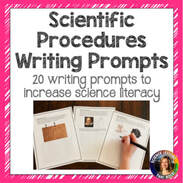Writing out CLEAR and DESCRIPTIVE scientific procedures is hard for students. It takes practice! Many teachers start off with a fun activity like how to make a peanut butter and jelly sandwich. Students will likely forget some important steps! This Youtube version made me smile:
Anywho, it’s important for students to be given opportunities to practice writing experimental procedures and not just be given what we call “cookbook labs” where everything is provided for them.
Here are some ways you can practice:
1. I created a set of 20 unique writing prompts that provide students experimental questions. I like that they not only get to practice writing procedures, but also get critical thinking practice- HOW could they test and set up an experiment to answer the question? It can be helpful to work through an example as a class and then set them loose.
(If you are interested in other writing prompt sets, check out this post).
(If you are interested in other writing prompt sets, check out this post).
2. I came across this cool flextangle template and immediately thought “Students will love this! But how do I connect it to my curriculum?”
I think it would be fun to put students in pairs, and chop the paper in half- give one student the foldable template and the other student the directions. Have the student with the directions explain how to cut and fold the flextangle and see if they can do it successfully. After a while, you can show them the video of how the flextangle should work and see how they did. While students won’t actually be writing procedures, they will be explaining procedures, which is still great practice.
I think it would be fun to put students in pairs, and chop the paper in half- give one student the foldable template and the other student the directions. Have the student with the directions explain how to cut and fold the flextangle and see if they can do it successfully. After a while, you can show them the video of how the flextangle should work and see how they did. While students won’t actually be writing procedures, they will be explaining procedures, which is still great practice.
3. Have a favorite demo you love? Sneak in some writing practice! Show students the demo and tell them to watch what you do very carefully. After the demo, have them write out what you did step by step. You can do the demo a second time if they need to see it again to catch all the steps. After the demo, have a few students read their procedures out loud and see how well they did.
4. In this free activity from Amy Brown Science, students build a unique structure and write out the procedures on how they built it. Then they swap instructions with another student and see if they can replicate the structure.
What other ways do you have students practice writing procedures? Leave me a comment!










